Table of Contents
Tiger Shrimp Overview
The Tiger Shrimp is a freshwater animal with tiger-like black stripes that adorn its beautiful body. The shrimp is a great choice for newbie aquarists because it doesn’t need intensive care like other shrimp species. It has been widely accepted since its introduction to the aquarium hobby, and it is becoming increasingly popular. Furthermore, shrimp are quite economically friendly in their captivity; they do not require much effort and care to thrive. They are very active swimmers and need plenty of space to move around, especially if they are kept in groups.
You can house the shrimp with other species like the Cherry shrimp in the same tank. Although shrimp is a great choice for beginners in the hobby, breeding them requires someone capable of doing so. There are a lot of variables that go into breeding the shrimp that new aquarists may not be able to master.
| Information Chart | Tiger Shrimp |
|---|---|
| Scientific Name | Penaeus Monodon |
| Lifespan | 3-4 years |
| Care Level | Easy |
| Breeding | Hard |
| Water Temperature | 70-78°F (22-25°C) |
| pH Level | 6.5 – 7.5 |
| Temperament | Peaceful |
| Diet | Omnivore (predominantly carnivore) |
Appearance of Tiger Shrimp
Almost similar to the yellow tiger shrimp, it exhibits black stripes along its body and yellowtail. The red tiger shrimp, however, displays red stripes rather than black.
Interestingly, the tiger and red shrimp can mate and produce offspring. In the resultant offspring, the parents’ characteristics and physical characteristics will be seen.
Hybrid offspring of both shrimp species can exhibit either black or red stripes or sometimes show the features of the red cherry shrimp.
Types Of Tiger Shrimp
Blue Tiger Shrimp

Their name implies the color of their body; these royal blue shrimps have a blue body and black stripes, with brilliant orange eyes. They are also known as Orange Eyed Blue Tiger Shrimp.
Northern Tiger Prawn

Wild-caught from the northern waters of Australia, these brown colored and groovy shrimps can be grown in both marine and estuarine. They make the majority of the catch by the fisheries.
Lifespan Of Tiger Shrimp
The typical lifespan of the Tiger shrimp is around 3-4 years. The tiger shrimp caught in the wild lives up to 2 years.
Tiger Shrimp Size
Out of all the other commercially available shrimps, tiger shrimps can grow up to 13 inches. But their harvest size is from 9 to 11 inches.
Natural Habitat & Origin
Tiger Shrimp is native to the Asian continent and is fairly distributed in Asian countries. In China, for instance, these shrimps are found in the southern region in freshwater areas where they live in the wild. It is an inhabiting freshwater shrimp found in small streams and rivers in the wild.
Tiger Shrimp Care and Tank Setup
Water Parameters
It is a freshwater shrimp, so provide fresh water in the tank. The aquarist must regulate the water pH between 6.5 and 7.5. Just ensure that the tank water is soft. Ensure that the tank water is clean because any impurities in the aquarium can be fatal for the shrimp.
The temperature of the tank water should be regulated between 76-78°F. You can measure the exact temperature of your water with a No products found.. Perform frequent water changes to ensure that the shrimp survives there. You can do at least a 10% tank water change to help improve the conditions for the animal there.

Nitrogen/other nutrient requirements for Tiger Shrimp tank?
Another important thing is to check ammonia and nitrate levels in the water. You must keep these levels down for the tiger shrimps to survive. Don’t provide much lighting as the shrimp prefer darker areas.
Tiger Shrimp Care & Tank Set-up
Always remember the bigger the tank, and the more stable and better it is for the shrimps. Even though they can survive in a small tank, the water can quickly fluctuate in temperature and parameters leading to premature death in Tiger Shrimps. They don’t like frequent changes in water parameters.
On the other hand, healthy Tiger Shrimp breeds actively, which means offering them a bigger tank is best.
Tiger Shrimp Tank Size and Specification
Big tanks can also create issues. As these Shrimps are small, using a larger aquarium will make the tank appear underwhelming. It is not advisable to use a tank smaller than 5-gallon unless it is properly planted. If there are sufficient aquatic plants in the tank, then the nitrate and ammonia levels will remain in control.
Optimum Tank Size for Tiger Shrimp
Experts suggest going for a tank with a capacity of 20 to 25 gallons. A 2-foot tank can be the cheapest option for you. If you are planning to buy a used tank for your Shrimp, then you should be very careful as most used tanks are generally treated with copper, and for freshwater shrimp species, this is not a good thing.
Filter Type
Well, Tiger Shrimps filtration can get more complicated as you will have to consider the shrimp fry than the small nature of your Tiger Shrimps. If the filer is powerful, then it can breed baby Tiger Shrimps as well as adults. However, there are many cost-effective options using which you can easily modify the filters.
It is not a good idea to use a Canister filter as this can kill your shrimps. Most of the internal filters can work, and one of the best options will be the sponge filters. Sponge filters are quite durable and inexpensive. On the other hand, they can provide the Tiger Shrimps with more surface areas to graze on. Besides, these are very safe for them.
You can go for the HOB- Hand on Back filter system (also called power filters). These filters are a great choice. However, before you can use them, you need to modify the intake to prevent unwanted accidents. For example, you can put a sponge filter on the intake to avoid any losses.
Substrate
Your Tiger Shrimp tank should have some substrate covering the tank’s bottom. This way, you can ensure that your Shrimp will get a perfect grip while walking. If there is no substrate, they will struggle to walk around on the glass. You can go for the active or inert substrates.
The inert substrates will not change the parameters of the tank water, but you will have to use more supplements to keep the plants alive. As Tiger Shrimps require softer water, the best option is an active substrate. Besides, these are perfect for rooted plants as they will get all the required nutrients to grow. Experts say that an inert substrate will work well for Neocaridina Shrimps, as they like KH.
You can also use active soil, but this will lead to a longer cycle time. Tiger Shrimps are very sensitive to active soil as it creates more ammonia. So, prefer to add your Shrimp to the tank after stabilizing the water parameters.
How Many Tiger Shrimps in X Gallon Tank?
Around 10 Tiger shrimps can be kept in a 30-gallon tank.
Water Parameters for Tiger Shrimps
Water Temperature
The recommended water temperature is 76-78 °F / 24-25.5 °C
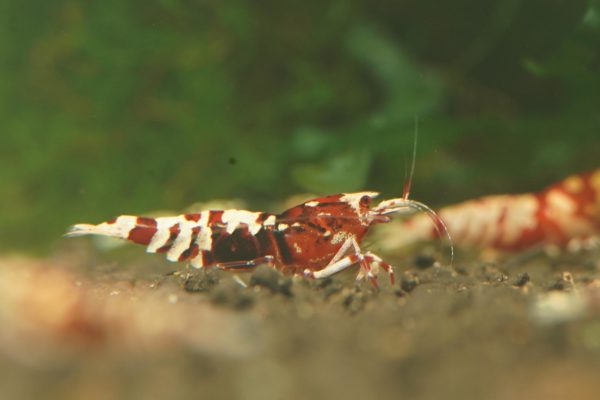
pH Level
The pH should be from slightly acidic (pH 6.5) to alkaline nature (pH 7.5). Keeping the nitrite and nitrate levels as low as possible is highly recommended.
Water Hardness
These tiger shrimps mostly prefer soft water.
Tiger Shrimp Tank Landscape
Tiger Shrimp Tank Heater
Using a tank heater can be confusing among the Tiger Shrimp keepers as the shrimps tend to survive in cooler temperatures. For better results, you need to ensure that the water temperature is 70 to 80-degrees F. However, if you live in a cold place, the room temperature will drastically freeze the water. Hence, it is a good idea to use an aquarium heater always with you to keep the water temperature at the desired level.
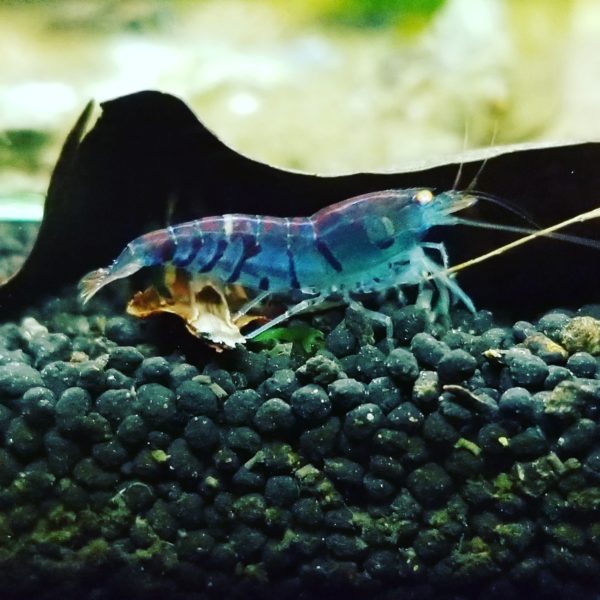
Best Plants for Your Tiger Shrimp
Using the right aquatic plants can keep your Tiger shrimp healthy. There are different types of aquatic plants that can help the tanks. They will keep ammonia and nitrate levels low and stabilized by functioning as a natural filter. For this purpose, you can opt floating plants as their growth rate is fast.
On the other hand, plants in the tank will offer surface areas for biofilm growth. And when the plants start dying off, it can be a portion of food for your shrimp. Furthermore, using aquatic plants, you can provide your shrimps with many hiding spaces. Some plants that you can use for your shrimp are:
- Water lettuce or duckweed
- Anubias
- Moss balls
- Java Fern and moss
- Rotalas
- Utricularia Graminifolia
- Cyprus and more
You need to keep in mind different parameters if you are planning to keep Tiger Shrimps. For instance, GH, TDS, Nitrate, pH, Ammonia, etc. Parameters for your Tiger Shrimps are as follows:
- TDS- around 800 to 100 (It measures total dissolved solids in the tank water.)
- Water temperature- 70 to 73-degree F
- pH- 6.5 to 7.5
- GH- around 4 to 8
- KH- around 2 to 6
Lighting For Your Tiger Shrimp
Lighting for your shrimp tank will vary based on the setup. As per professional aquarists, you can use LED lighting for your Tiger Shrimps tank. These are quite cheap, and a basic LED light is ideal for your shrimp tank if it doesn’t constitute any other living plants. To avoid excess plant growth, don’t keep the light turned on for more than 8 hours. If you have a planted tank, you may need an advanced lighting setup. Whether the shrimp tank has fertilizer or CO2 dosing will influence the lighting choice.
Feeding Tiger Shrimp
Feeding the shrimp is quite easy even when it is in captivity as it will readily eat a variety of foods. You can offer the animal foods like; spinach, lettuce, zucchini, algae wafers, and flakes. It is best to give the shrimp a balanced diet to help keep diet problems like nutritional deficiencies at bay. You can feed the shrimp once or two times a day. The other foods you can offer it include; blanched vegetables, hikari crab cuisine, and omega 1 shrimp pellets. Please also note that once you provide the shrimp food in the tank after 2-3 hours all the food needs to be consumed. If you notice that after this time all the food is not eaten, it is either you are offering too much food or they are scared to come out and eat.
Shyness in Tiger Shrimp is a problem that can prevent it from feeding well and it is usually caused by insufficient hiding places or bully tank mates. That said it is best to ensure that you house the animal with peaceful animals and offer it lots of hiding places.
Related Post: Bee Shrimp
Tiger Shrimp Tank Mates
Blue Tiger Shrimps are non-aggressive and peace-loving creatures, and they can live happily and healthy inside a tank environment. If you are planning to keep them in a community tank for breeding, you will have to make sure that there is a lot of hiding space in your tank. Besides, ensure that the aquarium has no predatory fishes. Else your shrimps may not survive in a community tank.
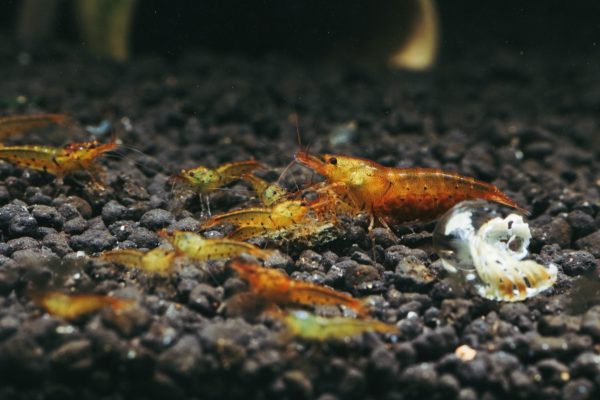
As per the experts, Tiger Shrimps should not be kept with other Cardian species. For instance, red, golden, or black Cardinia, White Beed, and other Tiger species. You should avoid this due to its huge risk of hybridization.
You should always remember that Tiger Shrimps eat a lot; they’re aggressive eaters. In fact, for food, they can easily outcompete Red Cherry Shrimps or Neocaridina. So, it is advisable not to keep them together. But you can go for Red Nose Shrimps, Malwa Shrimps, and Amano Shrimps if you are looking for some of the best tank mates for your Tiger Shrimps. They also eat very aggressively, and Tiger Shrimps will not bully them as they are bigger than Tiger Shrimps.
Don’t keep your Tiger Shrimps with other Neocaridina species, like Blue Velvet Shrimps or Snowball Shrimps, if you don’t want to lose your Tiger Shrimps’ colors. This can lead to the risk of hybridization. On the other hand, Snails, such as White Wizard Snails, Mystery Snails, Nerite Snails, and Rabbit Snails, can be perfect tank mates for your Tiger Shrimps. They can benefit your Shrimp as they can easily break down the food. Besides, as they create a lot of waste, they play a great role in the tank’s nitrogen cycle. They stir the available substrates to avoid the production of gas pockets.
Tiger Shrimp Breeding
The males and the females look almost similar although the female have a distinctive round-like structure underneath their bodies. The males are also slightly smaller in size compared to the females. The colors of the male and the female however remain the same and this can really be problematic if you are asked to tell them apart.
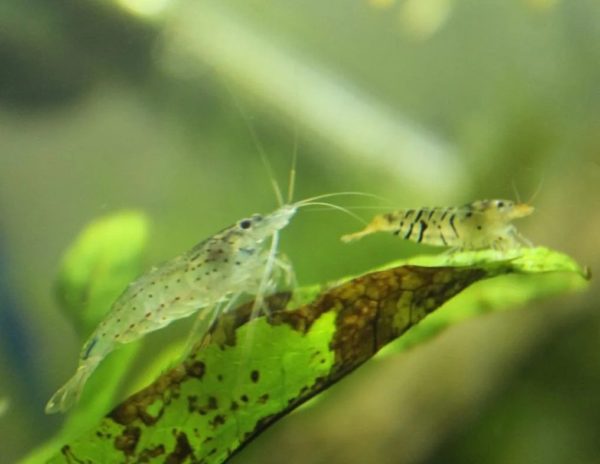
The tiger shrimp will easily breed just like other species of shrimp once the conditions are conducive. Ensure that the tank water is pure and free of any contaminants this helps to make the animal feel comfortable which is necessary for its breeding. The female shrimp will be able to produce anything from twenty to twenty five hatchlings provided it is feeling healthy and comfortable. The eggs will hatch and the female may take a period of at least seven days to again lay more eggs. Breeding the tiger shrimp is not complicated and once you learn the basics of doing things right, you will soon find that you are an expert in the field! During the period of breeding it is best to give the shrimp small amounts of food but at regular intervals. Remember continuous and reliable food sources for the shrimp is ideal for its successful breeding.
Tiger Shrimps Female and Male Difference
Well, if you look closely, female Tiger Shrimps are a little larger than male Tiger Shrimps. While the females can grow up to 2.5 CM to 3 CM, the males can only attain a size of 2 CM to 2.5 CM.
Besides, females will appear more curved compared to males. In terms of colors, they will have a darker appearance. Sometimes, the saddle of a Tiger Shrimp, especially a Blue Tiger Shrimp, will be challenging to see as they have a dark blue coloration.
So, while breeding your Tiger Shrimps, you should watch out for various sizes as if they are all the same; you may have a particular gender. Sort this out and make sure you have a perfect ratio of females and males to ensure the breeding is successful.
Enhancing Your Tiger Shrimp’s Immune System
It is normal for bacteria and pathogens to be present in a pond. They may not develop any health issues in the shrimps if they have a healthy immune system. So, if you are planning to keep Tiger Shrimps in your tank, you will have to take good care of the shrimps and make sure that they have a strong immune system and good gut health. This is possible only by using good feed additives.
One of the best things you can do is offer supplementation with selenium and zinc. As per some studies, zinc plays a major role in modulating the overall immune function effectively. As a result, you will have active Tiger Shrimps with better immune capabilities.
On the other hand, it speeds up the process of healing. Apart from zinc, you can also offer selenium supplementation, which plays a great role in your shrimp’s growth.
Aquatec Defender is the primary choice for most aquarists, which comprises a perfect combination of Saccharomyces Cerevisiae, selenium, and zinc. Different studies state that Shrimp care products improve the immune system and enhance your tiger shrimp’s performance.
Tiger Shrimps Diseases and Treatments
White Feces Disease
A common symptom of white feces disease is a change in gut color. The gut will turn pale white. As per some studies, your shrimp will stop eating. As the real reason for this issue is still unknown, you should follow best water management practices and biosecurity to lower the risk of this disease.
White Spot Disease
This disease was first identified in 1992 in Taiwan. One of the most common reasons behind this disease is a particular virus. Common symptoms include a rapid reduction in food consumption. Your shrimps may also display reddish-brown spots on the body. Well, to treat this condition, use chlorine.
EHP- Enterocytozoon Hepatopenaei
EHP is quite common, and the microsporidian parasite generally causes this disease. This disease can be prevented by better task management. Proper tank preparation can be practiced by removing all the accumulated organic matter, and the bottoms should be treated properly.
Fungal Diseases
Fungal diseases are generally found on dead shrimp skin. Small white patches can be visible on the shrimp’s body. This is quite common among Tiger Shrimps with poor immune systems. In most cases; the disease can resolve independently. However, persistent infections may need proper therapy with the help of a professional veterinarian.
Luminous Vibriosis
This can be very deadly to your Tiger Shrimps and kill all your Tiger Shrimp. To effectively prevent this, you should carefully monitor your Tiger Shrimps and verify the presence of bacteria. Besides, create microbial diversity and utilize probiotics to kill pathogens.
Are Tiger Shrimps Right for You?
Well, there are many positive things to say about Tiger Shrimps. They are very interesting to watch, and they also look very cute. You will feel that they will have their own little world in the tank. Tiger Shrimps are the indel addition to a community tank with small fish species and their own species.
They are a good cleanup crew, and they can eat uneaten food, fish poop, and algae. On the other hand, you don’t have to spend a lot of money to buy a Tiger Shrimp. A simple five to ten-gallon fish tank with a good quality filter and some Tiger Shrimp-friendly plants will be enough to keep your Tiger Shrimps healthy and happy.
Besides, breeding your Tiger Shrimps is quite easy as well as rewarding. However, there is one thing that you should always keep in mind: small Tiger Shrimps require more protection compared to adults.
Just follow the care tips mentioned here and create a perfect living environment for them, and you can easily keep them crawling around the tank for years. It can be said that Tiger Shrimps are a perfect option for beginner aquarists.
Facts About Tiger Shrimps
- Tiger Shrimps are good for your home aquarium. Adding a few Tiger Shrimps to your aquarium can add perfect diversity. They are lively compared to other species and also very social. Tiger Shrimps are also a source of great entertainment.
- They can eat anything. They spend most of the time at the bottom of the aquarium, consuming anything that comes down. As Tiger Shrimps are omnivorous, they can eat animals and plants. They eat worms, living plants, algae, snails, fish, etc.
- Unlike other fish species which lay eggs, Tiger Shrimps carry the eggs on the body’s underside. A Tiger Shrimp carrying eggs is called Berried shrimp. The tail fans the eggs to offer sufficient oxygen.
- They will molt as they grow. This is an important process for the Shrimp. They may shed the skin once a week. So, whenever you see a dead Tiger Shrimp lying on the tank floor, don’t panic, as this can be an exoskeleton of the shrimp.
- Tiger Shrimps will work hard to keep the tank clean. They don’t just eat the dead livestock but also consume algae.
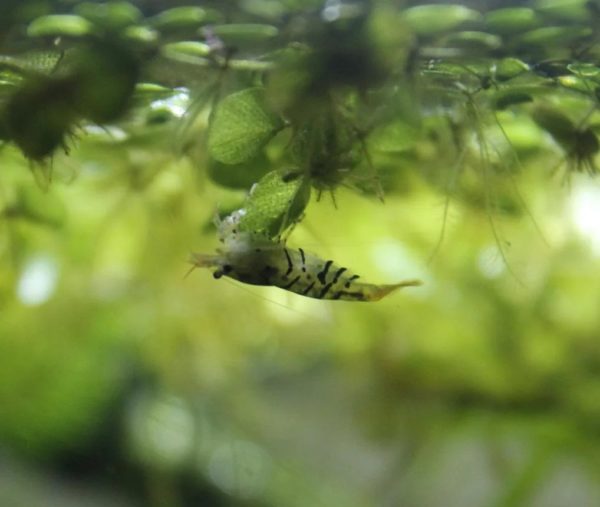
FAQs
Do Tiger Shrimps Need a Tank Heater?
Yes, Tiger Shrimps require a heater. The water temperature should be between 70 to 78-degrees F. During winters, the water temperature will go down, adversely affecting your Tiger Shrimps. As these Shrimps are extremely hardy, a slight change in the tank water temperature will not kill them instantly. But a suboptimal water temperature can lower the immunity of your Tiger Shrimps and can affect their molting process.
What is Required for A Tank for Your Tiger Shrimps?
Well, you may need a lot of live plants, hiding spaces, pebble substrate, normal tank lighting, a sponge filter, and a standard water heater.
The Tiger Shrimps are not picky about their living environment. Rather they love a heavily planted aquarium as living plants offer them space to graze. Keep the tank clean and always maintain the right water parameters, and your Tiger Shrimp will grow healthy.
How Many Tiger Shrimps Can I Keep in A 10-Gallon Tank?
You can keep around 15 to 20 Tiger Shrimps in a 10-gallon aquarium. They are small and don’t produce much waste. For a beginner, using a 5-gallon tank can be a good option. As per the general rules, you can add 2 to 5 Tiger Shrimps per gallon of water.
Are Tiger Shrimps Social?
Yes, Tiger Shrimps are very social. They love to live in a group, but the group must have the same species. They adapt better and also feel comfortable when living in a colony. In your tank, you should keep around 10 Tiger Shrimps.
Conclusion
Tiger Shrimp is a freshwater shrimp that is native to the Asian continent and some are found in the Southern parts of China. Since its introduction into the aquarium hobby it has really gained a huge number of enthusiasts. It is quite easy to rear in the tank because it is not as demanding as some other species of shrimps. Once you have a tank properly set up with its recommended parameters and ensuring that substances such as ammonia and nitrates are kept low you will be good to go. Performing regular water changes is also desirable to help keep the animal comfortable and healthy for the shrimp. You can purchase the animal across pet shops that deal in fish and other related aquarium animals.
No related posts.

1 thought on “Tiger Shrimp : Complete Guide to Care, Breeding, Tank Size and Disease”
I need a profdssional shrimp breeding guide and additive to feed them during nursery.